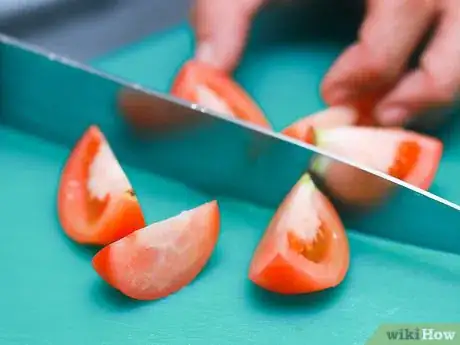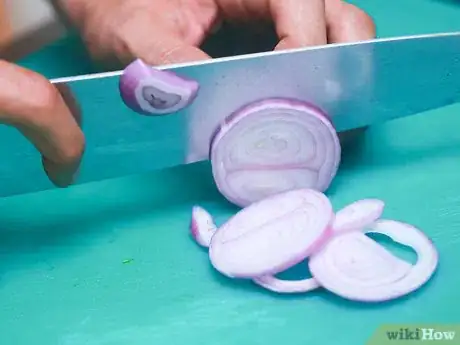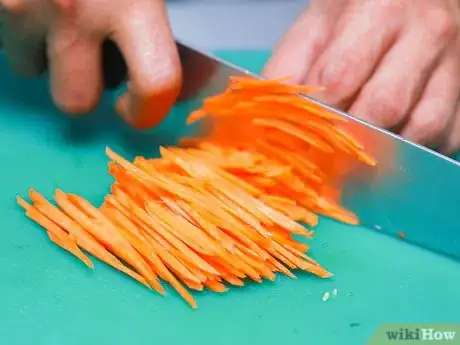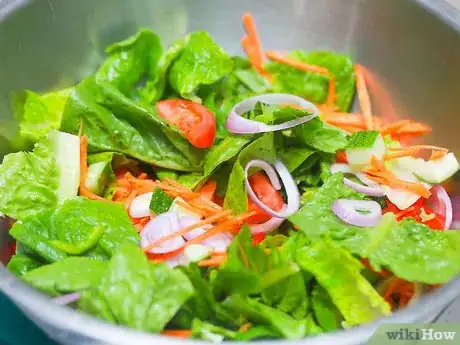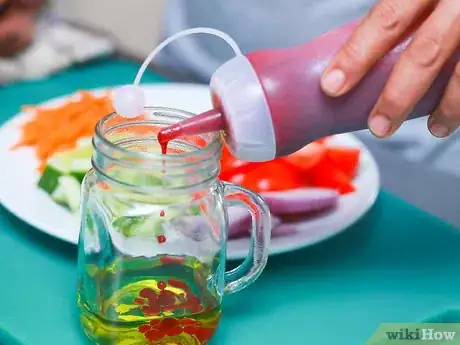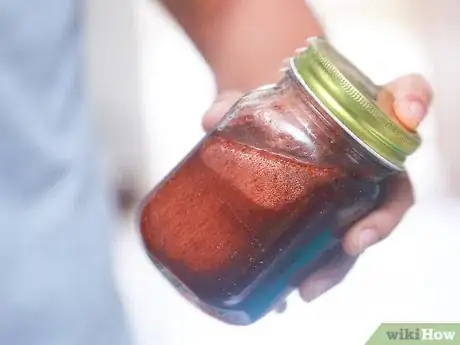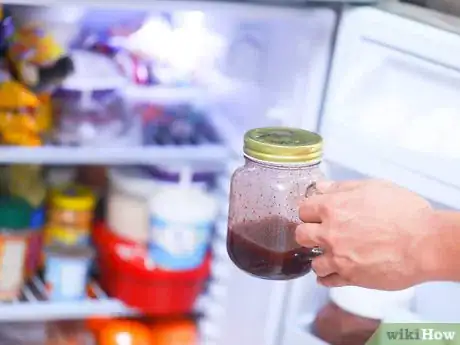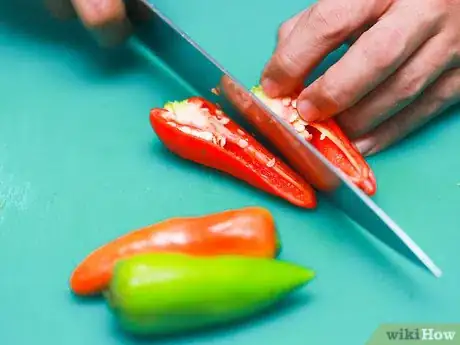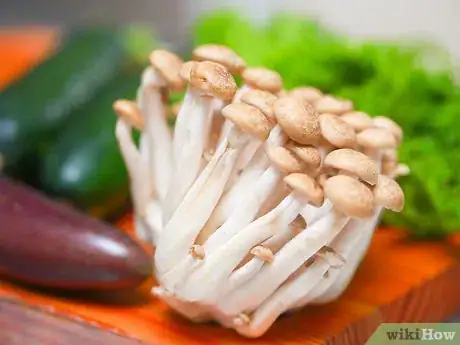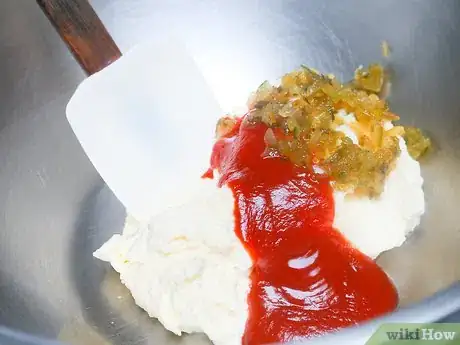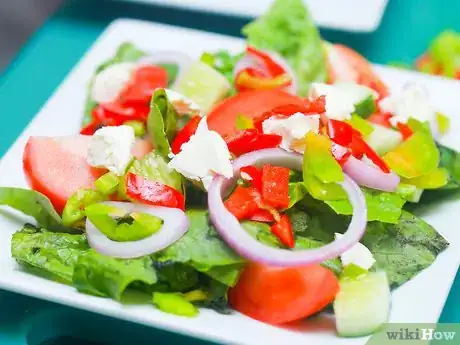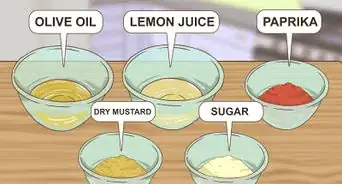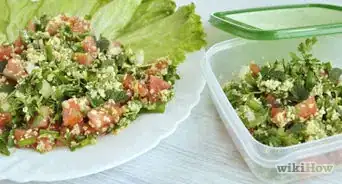This article was co-authored by Marrow Private Chefs. Marrow Private Chefs are based in Santa Rosa Beach, Florida. It is a chefs’ collaborative comprised of an ever-growing number of chefs and culinary professionals. Though regionally influenced primarily by coastal, traditional southern, cajun, and creole styles and flavors, the chefs at Marrow have a solid background in all types of cuisine with over 75 years of combined cooking experience.
There are 7 references cited in this article, which can be found at the bottom of the page.
wikiHow marks an article as reader-approved once it receives enough positive feedback. In this case, 100% of readers who voted found the article helpful, earning it our reader-approved status.
This article has been viewed 329,922 times.
Garden salads are not only healthy and nutritious but also colorful. They can be made with vegetables straight from your garden, including carrots, cucumbers, and tomatoes. Once you know how to make a basic garden salad, you can alter it and put your own spin on it. This article will not only show you how to make a basic garden salad and a tasty dressing for it but also give you ideas on how to customize it to suit your tastes.
Ingredients
- 1 head Romaine lettuce
- 1 tomato
- ¼ purple onion
- ½ cucumber
- 1 carrot
Makes 4 servings
- 3 tablespoons olive oil
- 1 tablespoon white wine vinegar
- Pinch of salt
- Dash of pepper
Steps
Making the Salad
-
1Cut the leaves off the lettuce. Unless you bought your lettuce already cut into bite-sized pieces, you will need to cut the leaves off the lettuce head. Simply lay the lettuce down on its side and cut the base off where all of the leaves are gathered.
-
2Cut the lettuce into smaller pieces. Place a few leaves on top of each other and start chopping the lettuce horizontally. You can also simply tear the lettuce into smaller pieces using your fingers. If the lettuce you are using has a thick stem in the middle, be sure to cut it out and discard it.Advertisement
-
3Wash and dry the lettuce. Fill a clean sink or bowl with cool water and place the leaves inside. Gently move the leaves about to dislodge any dirt. Once the lettuce is clean, dry it using a salad spinner, or set the leaves down on a clean towel and pat them dry with another towel.[3] The leaves must be dry, or else the dressing will not stick to them.[4]
-
4Cut the tomato into wedges. Place the tomato down on the cutting board with the stem facing you, and cut it in half using a serrated knife. Take one of the halves and place it cut-side-down on the cutting board. Cut it in half again, going from the top of the tomato (where the stem is) to the bottom. Cut each half into wedges. Start from the domed part of the tomato and cut down towards the middle, where the stem was. Repeat the process for the other half.[5]
- You can also use whole cherry or grape tomatoes. You can use them whole or cut them in half.
-
5Slice an onion. Take ¼ of a purple onion and slice it into thin rings. Use your fingers to gently separate the rings. You can also dice the onion instead.
-
6Slice a cucumber. You can peel the cucumber first, or you can leave the skin on. Make sure that the slices are thin. You can also chop the cucumber into cubes.
-
7Chop up a carrot. You can chop the carrot up into thin slices, or you can grate it. You can also use whole baby carrots as well.
-
8Place all the vegetables into a bowl and toss them together. Use a pair of salad serving spoons to gently scoop up some salad and drop it back into the bowl. Pick up some more salad and drop it into the bowl. Keep tossing the salad like this until all o the vegetables are evenly dispersed throughout the salad.
-
9Add a salad dressing of your choice. You can use a store-bought, pre-made dressing, or you can make your own from scratch. If you wish to make your own, refer to the section in this article on making basic salad dressing. Pour some dressing into the salad and toss it. You can add as much or as little dressing as you like. In general, the greens should be lightly coated with the dressing, and not drenched so much that the dressing pools at the bottom of the bowl.
Making the Salad Dressing
-
1Find a glass jar with a tight-fitting lid. You will be mixing your salad dressing in this jar. If you do not have a jar, you can use a glass bottle instead. Avoid using plastic, as that can affect the flavor.
-
2Pour all the ingredients into the jar. You will need 3 tablespoons (44.4 ml) of olive oil, 1 tablespoon (14.8 ml) of white wine vinegar, a pinch of salt, and a dash of pepper. For a heavier dressing, use extra virgin olive oil. If you want a lighter dressing, use light olive oil instead.
- You can also use canola, grape seed oil, or vegetable oil instead of olive oil. These will give you a more delicate flavor.
- Instead of white wine vinegar, you can also use apple cider vinegar, balsamic vinegar, red wine vinegar, or rice vinegar.
-
3Consider adding in some extra flavor. You can customize your salad dressing by adding some fresh herbs, honey or sugar, or garlic. Here are some options for you to choose from:[6]
- For a fresh, herbal touch, add 1–2 tablespoons (14.8–29.6 ml) of chopped, fresh herbs, such as basil, cilantro, parsley, mint, or thyme.
- For a sharper flavor, add 1 finely-mined garlic clove. You can also use a garlic press instead.
- For a cheesier option, add 2 tablespoons (29.6 ml) of finely grated or crumbled cheese, such as parmesan.
- Add some spice with a pinch of crushed red pepper flakes or 1 teaspoon of dijon mustard.
- Add a little sweetness with ½ to 1 teaspoon of 1/2 – 1 honey or sugar.
-
4Shake the jar. Close the lid tightly and shake the jar until all of the ingredients are combined. If any of the dressing has seeped out from beneath the lid, wipe it off with a damp towel. You can use this dressing on your salad and store any leftovers in the refrigerator.
-
5Store the dressing properly. If you have any salad dressing left over, close the jar tightly and store it in the refrigerator. Use it within two to three days.[7]
Making Variations
-
1Consider customizing your salad. Garden salads are easily-customizable. You can add more vegetables, use completely different vegetables, or even change the dressing. This section will give you some ideas.
-
2Use different vegetables. You can substitute the vegetables in your salad for other ones. You can also simply toss more vegetables into your salad in addition to the ones you already have to make it more colorful and flavorful. Other vegetables often found in garden salads include black olives, mushrooms, onions, radishes, red bell peppers, and green bell peppers.
-
3Use a different salad dressing. If you don't like basic salad dressing, you can use a different instead, such as French, Italian, red wine vinaigrette, or ranch. You can also forgo the dressing altogether and lightly season your salad with some olive oil and a drizzle of lemon juice or vinegar, and a pinch of salt and pepper.[8]
-
4Add some toppings. You can give your salad some more flavor or crunch by adding shredded parmesan cheese on top, or some of your favorite croutons.
-
5Add a Greek spin to your salad. Keep the cucumber, onion, and tomatoes in the salad, but switch out the carrot for some chopped red and green peppers and sliced black olives. Add some crumbled feta cheese and crumbled oregano. Toss everything into a bowl and mix together. Finish off with some Italian salad dressing.[9]
- You can make the salad with lettuce, or omit it completely.
-
6Make an East Asian salad. You will need a ½ cup (125 grams) of corn kernels, 1 diced tomato, ½ cup (75 grams) of diced cucumber, 3 tablespoons (44.4 ml) of diced pineapple, and a few sprigs of dried coriander. You will also need ½ cup (50 grams) sprouted mung beans (drained) and 3 tablespoons of pomegranate seeds. Toss everything into a bowl. At this point, you can some salad dressing, salt, and pepper, or keep it simple with 1 teaspoon lemon juice.
Community Q&A
-
QuestionHow many calories in a garden salad?
 Community AnswerIt depends on the ingredients and the amount. Get the calorie count for one ingredient you used, divide it by how many servings there are, and repeat for the rest of the ingredients. Then add them all together.
Community AnswerIt depends on the ingredients and the amount. Get the calorie count for one ingredient you used, divide it by how many servings there are, and repeat for the rest of the ingredients. Then add them all together.
References
- ↑ Fresh Easy Meals, Garden Salad
- ↑ Kitchen Treaty, How to Make a Simple Vinaigrette Salad Dressing
- ↑ Fine Cooking, How to Make a Great Green Salad
- ↑ Huffington Post, Common Salad Mistakes
- ↑ The Kitchn, 3 Essential Tips for Cutting Tomatoes
- ↑ Kitchen Treaty, How to Make a Simple Vinaigrette Salad Dressing
- ↑ Kitchen Treaty, How to Make a Simple Vinaigrette Salad Dressing
- ↑ The Kitchn, 5 Salad Dressings to Know by Heart
- ↑ Taste of Home, Greek Garden Salad
About This Article
To make a garden salad, cut a head of lettuce into bite-sized pieces. You can use Romaine lettuce or whatever kind of lettuce that you like. After you've chopped the lettuce, rinse it well by soaking the leaves in a bowl of water and then drying them off. Then, slice a tomato into wedges and slice a red onion, using your fingers to separate the rings. Cut up a cucumber and a carrot and put all of your veggies into a bowl. Mix in your dressing and enjoy! To learn how to make a salad dressing from scratch, read on!



